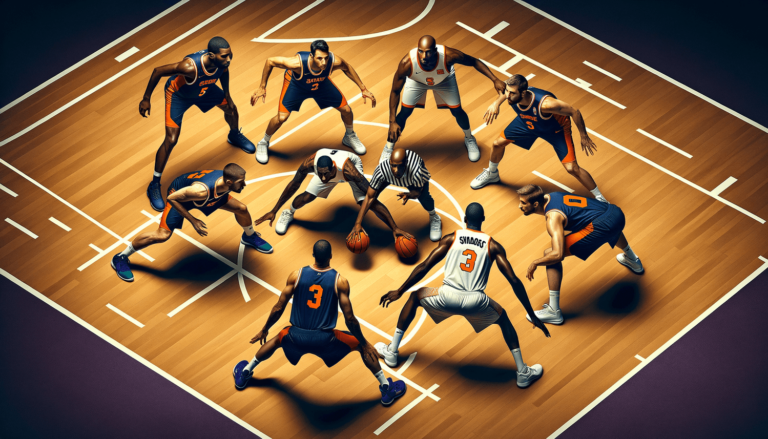
For basketball enthusiasts and curious cats alike, there’s a fascinating defensive strategy brewing on the court: the 1-2-1-1 zone defense. It has an almost enigmatic appeal as it combines the best elements of some classic defensive techniques with a dash of dynamism. While not quite a magic potion, the 1-2-1-1 zone defense has just the right ingredients to disrupt opponents and create chaos on the court. So put on your game faces and warm up those cerebral muscles, because we’re about to dive into the mesmerizing world of the 1-2-1-1 zone defense and unlock its secrets for you to apply as you watch or play the greatest game there is – basketball!
What’s a 1-2-1-1 Zone Defense in Basketball?
A 1-2-1-1 zone defense in basketball is a full-court defensive strategy that involves positioning players in a 1-2-1-1 formation, with one player pressuring the ball handler, two players covering the wings of the court, one player acting as a free safety in the middle, and the last player protecting the basket. This formation aims to disrupt the offensive flow, force turnovers, and apply constant pressure on the opposing team throughout the entire court.
Getting Into Formation: The Positions
Before we break down the intricacies of the 1-2-1-1 zone defense, let’s first understand the roles and responsibilities of each player on the court in this formation. Remember, every player plays a crucial part in making the 1-2-1-1 zone defense as effective as possible.
Point Guard (PG): The Ball-Handler Disruptor
In the 1-2-1-1 zone defense, the point guard is positioned at the top of the defensive formation, responsible for applying relentless pressure on the opposing team’s ball handler. With agility and an infectious in-your-face attitude, the PG’s goal is to disrupt the offense’s rhythm, making it more challenging to initiate plays and navigate the court.
Forwards (F1 and F2): The Wing Wizards
Situated behind the point guard and on the wings, the forward duo (F1 and F2) are the Wing Wizards of the 1-2-1-1 zone defense. Tasked with covering passing lanes and intercepting cross-court passes, these players must possess exceptional court awareness and anticipation skills. By remaining active and flexible, the forwards ensure that the ball is forced towards the sidelines, limiting the opponents’ opportunities for easy baskets.
Center (C): The Roamer Ruler
The center plays the role of a helmsman in this defense, roaming the middle of the court as a free safety. This agile giant must have an uncanny ability to read the offense and react quickly to developing plays. The center acts as the primary line of defense and, when needed, swiftly transitions from a helper to an on-ball defender. In essence, the center is the cog that holds the entire 1-2-1-1 zone defense machine together.
Power Forward (PF): The Back-Line Boss
Anchoring the defensive formation is the power forward, who takes on the responsibility of the back-line boss in the 1-2-1-1 zone system. The main priority for this player is to protect the basket and secure rebounds. In addition to being the ultimate shot-altering presence, the PF must successfully communicate with teammates to ensure that all possible gaps in the defense are closed off in a timely manner.
Unlocking the Secrets: Tactics for Success
By nature, the 1-2-1-1 zone defense is highly disruptive and challenging for any opposing team to contend with. To maximize this advantage, we’ll provide you with the keys to the kingdom in the form of tried-and-true tactics to employ in the game of basketball for ultimate 1-2-1-1 zone defense success.
Trap, Trap, and Trap Again
Trapping is a cornerstone skill in the 1-2-1-1 zone defense. The goal is to force the ball handler into uncomfortable situations where they’re either double-teamed or forced to take low-percentage shots. When the ball is pushed towards the sideline, the Wing Wizards (F1 and F2) are primed and ready to trap the ball handler with assistance from the Ball-Handler Disruptor (PG). Remember, the more pressure you apply, the higher the likelihood of causing turnovers.
Flexibility in Transition
In the world of the 1-2-1-1 zone defense, flexibility is king. As plays develop or turnovers occur in a game of basketball, defenders must rapidly adjust their positions and roles to maintain the integrity of the formation. For example, should the ball be lobbed over our Ball-Handler Disruptor, the PG must immediately switch roles with the Wing Wizard (F1 or F2) and maintain the formation. Practicing an immediate switch will keep the opposition flustered and confused.
Anticipate and Intercept
Developing an elite ability to anticipate opponents’ moves might as well be a superpower in the 1-2-1-1 zone defense world. By reading the eyes of the ball handler, players can identify potential passing lanes and position themselves for a steal or pass deflection. Keep in mind that anticipation involves both mental and physical preparedness—maintain an active stance and be ready to move on a moment’s notice.
Communication: The Unseen Glue
Solid communication between teammates is the unseen glue that binds the 1-2-1-1 zone defense together. Utilize clear and concise verbal and non-verbal cues to enhance defensive cohesion. For instance, your Roamer Ruler (C) should communicate with the Back-Line Boss (PF) to ensure they are aware of any cutting players or potential backdoor attempts.
Finding the Perfect Balance: Adjustments and Adaptability
As with any defensive strategy in basketball, the 1-2-1-1 zone defense isn’t immune to counterattacks. Skilled and well-coached teams will inevitably adjust their offensive tactics to break through your swarming press. It’s essential to recognize when changes are needed and adapt your defense accordingly.
Applying Pressure without Over-Committing
One of the biggest challenges with the 1-2-1-1 zone defense is striking the perfect balance between applying relentless pressure and not over-committing on traps. Remember to prioritize controlled aggression over reckless pursuit. Maintaining positional integrity will always give you an edge – don’t let it slip away.
Switch It Up: Adapting to Opposing Offenses
As teams start breaking through your 1-2-1-1 zone defense, it’s important to recognize the need to make adjustments. Experiment with varying trap locations, becoming more selective on when to initiate traps, or even changing up your defensive formation entirely. Variety is the spice of life and can throw off an opponent’s game plan.
Identifying and Exploiting Your Strengths
Finally, it is important to recognize the unique strengths of your team’s players and how they fit into the 1-2-1-1 zone defensive scheme. Understand and leverage individual strengths to exploit opposition weaknesses. Some teams might excel with a more aggressive press, while others might find success in employing a more conservative approach. Don’t be afraid to make adjustments on the fly – find what works best for your team!
The 1-2-1-1 zone defense in basketball is an exciting and disruptive full-court defense strategy that can create chaos for the opposition while also maximizing your team’s strengths. By understanding the positioning, roles, and tactics involved, as well as the need for adaptability and adjustments, you’ll have a powerful tool in your basketball coaching and playing arsenal. Now go out there, apply these tips, and watch as your defensive prowess takes center stage on the court!
Drills to Master the 1-2-1-1 Zone Defense
To make the most of the 1-2-1-1 zone defense, it is essential to practice specific drills designed to hone the skills and teamwork required to perfect this strategy. Incorporating these drills into your basketball training routine will not only help your team understand the principles of the 1-2-1-1 zone defense but also help reinforce the techniques and communication needed for success.
1. Defensive Slides
For any defensive strategy, lateral quickness and agility are key to staying in front of the ball handler and maintaining proper positioning. To improve in this aspect, practice defensive slides. This drill should be conducted with players starting in a low defensive stance and sliding side-to-side across the court. Emphasize proper footwork and encourage players to be active and quick on their feet.
2. Sideline Trapping
Practicing sideline traps is essential for the 1-2-1-1 zone defense. Set up a drill with a ball handler on the sideline and two defenders initiating the trap (one from the front and one from the side). This drill will help both the trappers and the ball handlers familiarize themselves with high-pressure situations and develop poise and decision-making skills under duress.
3. Pass Deflection and Anticipation
This drill focuses on anticipating passes and deflection skills. Divide players into two groups (offense and defense) in a half-court setting. The offensive team moves the ball around the perimeter, while the defensive players focus on deflecting or intercepting passes. This drill will sharpen cort awareness, defensive reactions, and timing.
4. Full-Court 1-2-1-1 Scrimmage
Once players have developed their individual skills, incorporate the 1-2-1-1 zone defense into a full-court scrimmage. This will not only help your team understand how the strategy works in real-time but also recognize when adjustments need to be made due to the dynamic nature of a basketball game. Keep in mind that positive reinforcement and constructive feedback are essential to learning and growth.
A 1-2-1-1 Zone Defense for Different Levels of Play
Though the 1-2-1-1 zone defense can be applied at various levels of basketball, it is essential to tailor the strategy according to the skill set and experience of your team members, as well as the level of competition they will face. Adjustments might be necessary to ensure the effectiveness and enjoyment of the game when implementing this defense.
Youth Level
At the youth level, it is crucial to establish a strong foundation of defensive fundamentals. While the 1-2-1-1 zone defense can be introduced, the focus should be primarily on teaching proper stance, footwork, and communication. Additionally, encouraging teamwork, fair play, and enjoyment of the game should be prioritized.
High School and College
As players progress to high school and college levels, their understanding of the game and physical and mental capabilities develop significantly. The 1-2-1-1 zone defense can be deployed more aggressively, focusing on traps, interceptions, and transition plays. Strategy and in-game adjustments can be more nuanced, allowing for a higher level of tactical execution.
Professional Level
At the professional level, athletes possess exceptional basketball skills and knowledge. The 1-2-1-1 zone defense can be executed at the highest level with a focus on exploiting opponents’ weaknesses and making split-second adjustments. Nevertheless, it is essential to consider the caliber of the opposition and adapt the strategy accordingly.
Incorporating the 1-2-1-1 zone defense into any level of play, from youth to professional, can provide teams with an effective and disruptive defensive strategy. By tailoring the approach to meet the needs and abilities of players at each level, the 1-2-1-1 zone defense can serve as a powerful tool in the game of basketball, bringing fun, excitement, and ultimately, success on the court.
FAQ Section: Your 1-2-1-1 Zone Defense Queries Answered
Feeling both excited and curious? No worries! We’ve compiled a comprehensive list of the most frequently asked questions regarding the 1-2-1-1 zone defense to further satisfy your thirst for knowledge. Get ready to quench your curiosity and become an absolute expert on this powerful defensive strategy in basketball.
1. Can the 1-2-1-1 zone defense be used at all levels of play?
Yes, the 1-2-1-1 zone defense can be applied at various levels, from youth to professional. However, it is crucial to tailor the strategy according to the skillset and experience of the players, as well as the level of competition they will face. Focus on teaching fundamentals at the youth level and emphasize more complex aspects as the skill level advances.
2. What is the primary objective of the 1-2-1-1 zone defense in basketball?
The main objective of the 1-2-1-1 zone defense is to disrupt the offensive flow, force turnovers, and apply constant pressure on the opposing team throughout the entire court. This strategy aims to create chaos and unease for the opposing team, limiting their chances for easy baskets and straightforward plays.
3. How do the players’ roles differ in the 1-2-1-1 zone defense?
In the 1-2-1-1 zone defense, each player has specific roles: the point guard (PG) pressures the ball handler, the forwards (F1 and F2) cover the wings and passing lanes, the center (C) roams the middle as a free safety, and the power forward (PF) protects the basket and secures rebounds. Each position has a unique set of responsibilities and skills that contribute to the success of this defensive strategy.
4. Can a team effectively use the 1-2-1-1 zone defense throughout an entire game?
While it is possible to utilize the 1-2-1-1 zone defense for an entire game, adjustments and tactical changes may be necessary depending on how the opposing team adapts to the strategy. Coaches should be ready to switch up the defense, the level of aggression, or trap locations to remain unpredictable and keep opponents off-balance.
5. How does the 1-2-1-1 zone defense compare to other full-court defense strategies?
Compared to other full-court defenses like the 2-2-1 or the man-to-man press, the 1-2-1-1 utilizes a unique formation and a blend of classic defensive techniques. It places greater emphasis on disruption and controlled aggression, making it more difficult for opponents to execute offensive plays and find open shots.
6. How important is communication in the 1-2-1-1 zone defense?
Communication is an essential component of the 1-2-1-1 zone defense. Players must use clear and concise verbal and non-verbal cues to enhance defensive cohesion, address potential gaps, and ensure everyone is aware of their roles and responsibilities on the court.
7. Does the 1-2-1-1 zone defense require specific physical attributes or athletic abilities?
The 1-2-1-1 zone defense requires agility, quickness, speed, and great court awareness. While players of different physical attributes can excel within this defensive system, some roles may demand specific skillsets. For example, a ball-handling disruptor should have exceptional quickness and agility, while a back-line boss must possess the ability to be an intimidating shot-blocking presence.
8. How can a team improve their 1-2-1-1 zone defense?
To improve the 1-2-1-1 zone defense, focus on mastering the fundamentals: proper defensive stance, footwork, communication, and anticipation. Incorporating targeted drills and full-court scrimmages will help players develop the necessary skills and teamwork to excel in this defensive strategy.
9. What are some common adjustments that can be made to the 1-2-1-1 zone defense?
Adjustments to the 1-2-1-1 zone defense may include varying trap locations, changing the level of aggression, altering defensive formation, or switching roles within the formation. Being adaptive and making adjustments on the fly will help teams succeed in exploiting opponents’ weaknesses and counteracting their strategies.
10. Can the
Featured Posts
- No pillar pages found.





